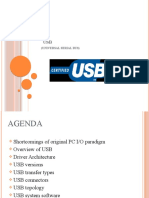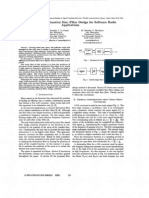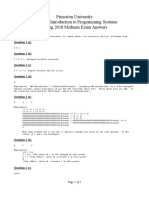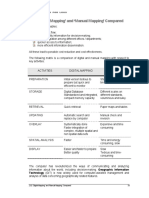A Technical Introduction To USB 2.0
A Technical Introduction To USB 2.0
Uploaded by
Sumeet KalraCopyright:
Available Formats
A Technical Introduction To USB 2.0
A Technical Introduction To USB 2.0
Uploaded by
Sumeet KalraOriginal Title
Copyright
Available Formats
Share this document
Did you find this document useful?
Is this content inappropriate?
Copyright:
Available Formats
A Technical Introduction To USB 2.0
A Technical Introduction To USB 2.0
Uploaded by
Sumeet KalraCopyright:
Available Formats
A Technical Introduction to USB 2.
0
This document introduces the features and benefits of USB 2.0 and describes its impact to users, PC manufacturers and PC peripheral manufacturers. Following a recap of USB 1.1, this paper overviews the technical aspects of USB 2.0 whose details are in the specification draft released in October. USB 2.0 Executive Summary A core team from Compaq, Hewlett Packard, Intel, Lucent, Microsoft, NEC and Philips is leading the development of the USB Specification, version 2.0, that will increase data throughput by a factor of 40. This backwards-compatible extension of the USB 1.1 specification uses the same cables, connectors and software interfaces so the user will see no change in the usage model. They will, however, benefit from an additional range of higher performance peripherals, such as video-conferencing cameras, next-generation scanners and printers, and fast storage devices, with the same ease-of-use features as todays USB peripherals. Impact to User From a users perspective, USB 2.0 is just like USB, but with much higher bandwidth. It will look the same and behave the same, but with a larger choice of more interesting, higher performance devices available. Also, all of the USB peripherals the user has already purchased will work in a USB 2.0-capable system. Impact to PC Manufacturer USB 2.0 will provide system manufacturers the ability to connect to high performance peripherals in the least expensive way. The additional performance capabilities of USB 2.0 can be added with little impact to overall system cost. Indeed, high-bandwidth interfaces such as SCSI adapters may no longer be required in some systems, leading to a net saving of system cost. Simpler construction will result since only USB connectors will be needed on many future PCs. Todays ubiquitous USB connectors will become USB 2.0, superceding USB 1.1. Impact to Peripheral Manufacturer Todays USB devices will operate with full compatibility in a USB 2.0 system. The added capabilities of USB 2.0 will expand the market segment for USB peripherals, while enabling retail products to transition with the installed base. Support of USB 2.0 is recommended for hubs and higher bandwidth peripherals. Designing a USB 2.0 peripheral will be a similar engineering effort to that of designing a USB 1.1 peripheral. Some low-speed peripherals, such as HID
devices, may never be redesigned to support the USB 2.0 high-speed capability in order to maintain the absolute lowest cost.
Historical Perspective Universal Serial Bus The Universal Serial Bus was originally developed in 1995 by many of the same industry leading companies currently working on USB 2.0. The major goal of USB was to define an external expansion bus which makes adding peripherals to a PC as easy as hooking up a telephone to a wall-jack. The programs driving goals were ease-of-use and low cost. These were enabled with an external expansion architecture, as shown in Figure 1, which highlights: PC host controller hardware and software, robust connectors and cable assemblies, peripheral friendly master-slave protocols, expandable through multi-port hubs.
Host PC
External Hubs Host Software Root Hub
USB Cables USB Peripherals
Figure 1. Example USB 1.1 System Configuration
Today, USB is enjoying tremendous success in the marketplace, with most peripheral vendors around the globe developing products to this specification. Virtually all new PCs come with one or more USB ports on the box. In fact, USB has become a key enabler of the Easy PC Initiative, an industry initiative led by Intel and Microsoft to make PCs easier to use. This effort sprung from the recognition that users need simpler, easier to use PCs that dont sacrifice connectivity or expandability. USB is one of the key technologies used to provide this.
Recap of USB 1.1 Operation An understanding of the roles of each of the major elements within a USB 1.1 system will better show the evolutionary step that USB 2.0 provides. Role of Host PC hardware and software. The role of the system software is to provide a uniform view of IO system for all applications software. It hides hardware implementation details so that application software is more portable. For the USB IO subsystem in particular, it manages the dynamic attach and detach of peripherals. This phase, called enumeration, involves communicating with the peripheral to discover the identity of a device driver that it should load, if not already loaded. A unique address is assigned to each peripheral during enumeration to be used for run-time data transfers. During run-time the host PC initiates transactions to specific peripherals, and each peripheral accepts its transactions and responds accordingly. Additionally the host PC software incorporates the peripheral into the system power management scheme and can manage overall system power without user interaction. Role of the hub. Besides the obvious role of providing additional connectivity for USB peripherals, a hub provides managed power to attached peripherals. It recognizes dynamic attachment of a peripheral and provides at least 0.5W of power per peripheral during initialization. Under control of the host PC software, the hub may provide more device power, up to a maximum of 2.5W, for peripheral operation. A newly attached hub will be assigned its unique address, and hubs may be cascaded up to five levels deep. During run-time a hub operates as a bi-directional repeater and will repeat USB signals as required on upstream (towards the host) and downstream (towards the device) cables. The hub also monitors these signals and handles transactions addressed to itself. All other transactions are repeated to attached devices. A hub supports both 12Mb/s (full-speed) and 1.5Mbs (lowspeed) peripherals. Role of the peripheral. All USB peripherals are slaves that obey a defined protocol. They must react to request transactions sent from the host PC. The peripheral responds to control transactions that, for example, request detailed information about the device and its configuration. The peripheral sends and receives data to/from the host using a standard USB data format. This standardized data movement to/from the PC host and interpretation by the peripheral gives USB its enormous flexibility with little PC host software changes. USB 1.1 peripherals can operate at 12Mb/s or 1.5Mb/s. What does USB 2.0 add? USB 2.0 is an evolution of the USB 1.1 specification, providing a higher performance interface. Todays USB 1.1 connectors and full-speed cables will
support the higher speeds of USB 2.0 without any changes. Characterization that has already been done on these cables confirms this compatibility. Analysis that has been done by the electrical team suggests that a target of 480Mbs is achievable on USB 2.0. USB 2.0 will specify a microframe, which will be 1/8 th of a 1msec frame. This will allow USB 2.0 devices to have small buffers even at high data rates. Support of higher speed USB 2.0 peripherals connected to a hub assumes USB 2.0 hubs as shown in Figure 2. The higher transmission speed is negotiated on a device-by-device basis and if the higher speed is not supported by a peripheral, then the link operates at a lower speed of 12Mb/s or 1.5Mb/s as determined by the peripheral.
USB 1.1 Hub USB 2.0 Hub
USB 2.0 Peripheral
Figure 2. Example Future USB 2.0 System Configuration
As shown in Figure 2, high-speed connections were negotiated between the root hub and the external USB 2.0 hub and between the external USB 2.0 hub and the video-conferencing camera (a USB 2.0 peripheral). All other connections are at USB 1.1 data rates, i.e. 12Mb/s automatically downshifting to 1.5Mb/s for lowspeed peripherals. Note that the external USB 2.0 hub has different signaling rates on its ports. Using a 40x multiplier for USB 2.0, the USB 2.0 hub example in Figure 2 has an input rate of 480Mb/s and output rates of 480Mb/s for attached high speed USB 2.0 peripherals, and 12Mb/s or 1.5Mb/s for attached USB 1.1 peripherals. Any downstream port of a USB 2.0 hub can support attachment of any speed USB device. The USB 2.0 hub must match the data rates sent out of
its downstream ports to the data rate appropriate to the attached device. This increases the hubs role in a USB 2.0 system as outlined below.
Overview of USB 2.0 Operation The external view of a USB 2.0 system looks no different from a USB 1.1 system as evidenced by comparing Figures 1 and 2. A casual observer will not be able to discriminate between the two system versions which is exactly the view the user should have. However, the user will have to be able to distinguish between USB 2.0 hubs and USB 1.1 hubs in order to optimize the placement of USB 2.0 high-speed devices. The roles of the components of the 2.0 system have minor changes from the roles in a USB 1.1 system. Role of Host PC software. Current applications software on the PC continues to operate with USB 1.1 peripherals and is unchanged. The system software will comprehend the increased capabilities of USB 2.0 peripherals so that it can optimize performance. The system software will also detect sub-optimal configurations, i.e. a USB 2.0 peripheral attached to a USB 1.1 hub, and will alert the user and recommend a better configuration for attaching the peripherals. New applications will be written to take advantage of the higher speed capabilities and ease-of-use of USB 2.0 peripherals and drivers. Role of the hub. A USB 2.0 hub accepts high-speed transactions at the faster frame rate and must deliver them to high-speed USB 2.0 peripherals and USB 1.1 peripherals. This data rate matching responsibility will require some increased hub complexity and temporary buffering of the incoming high-speed data. In the simplest case of communicating with an attached USB 2.0 peripheral, the hub repeats the highspeed signals on appropriate USB 2.0 upstream and downstream cables just as a USB 1.1 hub repeats full and low-speed signals today on USB 1.1 devices. This allows USB 2.0 peripherals to utilize the majority of USB 2.0 bandwidth. To communicate with USB 1.1 peripherals, a USB 2.0 hub contains a mechanism that supports the concept of matching the data rate with the capabilities of the downstream device. In other words, the hub manages the transition of the data rate from the high speed of the host controller to the lower speed of a USB 1.1 device. This feature of USB 2.0 hubs means that USB 1.1 devices can operate along with USB 2.0 devices and not consume disproportionate amounts of USB 2.0 bandwidth. This new hub architecture is intended to be as simple and cost effective as possible, and yet deliver the full capabilities of 1.1 connections. The new USB 2.0 hub will be completely defined in the USB 2.0 specification providing clear implementation guidelines for hub vendors and allowing a single software driver to service USB 2.0 hub products from multiple vendors. Role of the peripheral.
Current peripheral products do not require any changes to operate in a USB 2.0 system. Many Human Interface Devices, such as mice, keyboards and game pads will not require the additional performance that USB 2.0 offers and will remain as full or low speed peripherals as defined by USB 1.1. The higher data rate of USB 2.0 will, however, open up the possibilities of exciting new peripherals. Video-conferencing cameras will perform better with access to higher bandwidth. Next-generation, higher-speed and higher resolution printer and scanner devices will be enabled at the high-end. High density storage devices such as R/W DVD, and high capacity CDROM jukeboxes will also be enabled by USB 2.0. These devices require minor changes to the peripheral interface, as defined in the USB 2.0 specification. Overall, the additional cost to support USB 2.0 is expected to be minimal to the peripheral. Both USB1.1 and USB 2.0 devices will inter-operate in a USB 2.0 system. Summary The USB Specification is currently at Version 1.1 and supports a wide range of products. Many vendors are moving towards USB, drawn by its inclusion on virtually all PC platforms and its ease-of-use. More and more types of innovative new peripherals are taking advantage of USB, which further enhance the available USB product portfolio. The version 2.0 specification that is under development is an evolutionary step that increases performance capabilities at low cost for USB peripherals in a backwards compatible fashion. It is expected to broaden the market for new and higher performance PC peripherals, and supercede USB 1.1 on future PCs.
You might also like
- FDTD Reference Guide PDFDocument409 pagesFDTD Reference Guide PDFSumeet Kalra100% (2)
- A Technical Introduction To USB 2.0Document5 pagesA Technical Introduction To USB 2.0Moy CanoNo ratings yet
- Project Report 2Document62 pagesProject Report 2Alex VPNo ratings yet
- Super Fast Usb 3.0 What Is USB Stands For?Document4 pagesSuper Fast Usb 3.0 What Is USB Stands For?Sumit PandeyNo ratings yet
- USB Protocol BasicsDocument34 pagesUSB Protocol BasicsAmitav Shaw100% (2)
- Beagle AnalyzerDocument205 pagesBeagle AnalyzerbelzurkurNo ratings yet
- Character Design 125 TestDocument3 pagesCharacter Design 125 TestSheen Kenjie RefugioNo ratings yet
- USB Made Simple - Part 1 PDFDocument5 pagesUSB Made Simple - Part 1 PDFyeniuye100% (1)
- USB GuideDocument38 pagesUSB GuideRamesh Ramasamy100% (1)
- BookDocument29 pagesBookAnonymous yy8In96j0rNo ratings yet
- Universal Serial Bus (Usb)Document18 pagesUniversal Serial Bus (Usb)saranaccel1No ratings yet
- What Is Usb 3.0 (Aka. Superspeed Usb) ?Document13 pagesWhat Is Usb 3.0 (Aka. Superspeed Usb) ?gambit89No ratings yet
- What Is Usb 3.0 (Aka. Superspeed Usb) ?Document13 pagesWhat Is Usb 3.0 (Aka. Superspeed Usb) ?gambit89No ratings yet
- 001-57294 AN57294 USB 101 An Introduction To Universal Serial Bus 2.0Document57 pages001-57294 AN57294 USB 101 An Introduction To Universal Serial Bus 2.0Arturo Picolin100% (1)
- USB in A NutShellDocument33 pagesUSB in A NutShellNaveed AhmedNo ratings yet
- USB in A NutshellDocument40 pagesUSB in A Nutshellpraveen_vendraNo ratings yet
- USB in A NutShellDocument35 pagesUSB in A NutShellSandro Jairzinho Carrascal Ayora100% (1)
- Character Design 125 ReviewDocument3 pagesCharacter Design 125 ReviewSheen Kenjie RefugioNo ratings yet
- USB Background - TOTALPHASEDocument21 pagesUSB Background - TOTALPHASETechnical NoviceNo ratings yet
- History: Compaq DEC IBM Intel Microsoft NEC NortelDocument24 pagesHistory: Compaq DEC IBM Intel Microsoft NEC NortelRajesh MandalNo ratings yet
- USB - Under The Hood and Looking Forward: A White PaperDocument7 pagesUSB - Under The Hood and Looking Forward: A White Paperskovit100% (2)
- Usb-3 0Document31 pagesUsb-3 0dhavalbe1272100% (1)
- Universal Serial Bus (USB) : A Seminar Report OnDocument22 pagesUniversal Serial Bus (USB) : A Seminar Report OnAbdulkhadar KitturNo ratings yet
- What Is USB 2.0?: Logitech G5 G7 G15 Razer LachesisDocument4 pagesWhat Is USB 2.0?: Logitech G5 G7 G15 Razer LachesisankurjeNo ratings yet
- Universal Serial Bus (USB) Is A Serial Bus Standard To ConnectDocument22 pagesUniversal Serial Bus (USB) Is A Serial Bus Standard To ConnectMahesh Supekar100% (1)
- Eeiol 2011apr11 Int Net Pow Ta 01Document3 pagesEeiol 2011apr11 Int Net Pow Ta 01Ronggowasito LiegeNo ratings yet
- Usb 3.0Document27 pagesUsb 3.0Umar Rahamatullah Shareef100% (1)
- Universal Serial BusDocument28 pagesUniversal Serial BusAditya JalaliNo ratings yet
- Universal Serial Bus (USB) Is A SpecificationDocument4 pagesUniversal Serial Bus (USB) Is A Specificationmirajshah05No ratings yet
- Wireless Usb Full Seminar Report Way2project - inDocument22 pagesWireless Usb Full Seminar Report Way2project - inmanthapan0% (1)
- Usb Seminar ReportDocument33 pagesUsb Seminar ReportTuhina Nath100% (1)
- How USB WorksDocument7 pagesHow USB Works123.shalini100% (1)
- USB in Industrial Measurement and Control ApplicationsDocument7 pagesUSB in Industrial Measurement and Control ApplicationsMarcoRuizNo ratings yet
- USB DriverDocument2 pagesUSB DriverSharath PanickerNo ratings yet
- PSPHET406: VHDL & Communication Interface: UNIT-3: Understanding USB and USB ProtocolsDocument29 pagesPSPHET406: VHDL & Communication Interface: UNIT-3: Understanding USB and USB ProtocolsVidhi JaiswalNo ratings yet
- Universal Serial BusDocument28 pagesUniversal Serial BusSahil PatwardhanNo ratings yet
- Usb 3.0Document36 pagesUsb 3.0ravindra022100% (1)
- 001-57294 AN57294 USB 101 An Introduction To Universal Serial Bus 2.0Document58 pages001-57294 AN57294 USB 101 An Introduction To Universal Serial Bus 2.0Dani DaniNo ratings yet
- Usb On The GoDocument12 pagesUsb On The GokopeckNo ratings yet
- Universal Serial Bus (US B) : EE 446 Embedded ArchitectureDocument34 pagesUniversal Serial Bus (US B) : EE 446 Embedded ArchitectureRonabolNo ratings yet
- Usb History ResumDocument7 pagesUsb History ResumjordanvicenteNo ratings yet
- Common USB Development Mistakes - Farnell UkDocument7 pagesCommon USB Development Mistakes - Farnell Uklxz5101No ratings yet
- Troubleshooting USB 2.0 Problems With Your Oscilloscope - : Application NoteDocument14 pagesTroubleshooting USB 2.0 Problems With Your Oscilloscope - : Application NoteLeonardo GurmanNo ratings yet
- Character Design 125 SurveyDocument3 pagesCharacter Design 125 SurveySheen Kenjie RefugioNo ratings yet
- Documentation of USB 3.0Document26 pagesDocumentation of USB 3.0srinidhi2allNo ratings yet
- Usb 3.0 Seminar Report MiniDocument16 pagesUsb 3.0 Seminar Report MiniSiru ShaajanNo ratings yet
- Universal Serial BusDocument11 pagesUniversal Serial BusDileepmk10No ratings yet
- USB & SCSI & Privileged and Non-PrivilegedDocument15 pagesUSB & SCSI & Privileged and Non-Privilegedsouravmittal2023No ratings yet
- Icon Design Recommendation For Identifying Usb 2.0 Ports On PCS, Hosts and HubsDocument3 pagesIcon Design Recommendation For Identifying Usb 2.0 Ports On PCS, Hosts and HubsssfofoNo ratings yet
- Getting Started With FX2LPDocument28 pagesGetting Started With FX2LPFaveOfTheSunNo ratings yet
- Submitted By: Rahul Yadav 07EI 438 4/7/2011 4/7/2011Document18 pagesSubmitted By: Rahul Yadav 07EI 438 4/7/2011 4/7/2011Praveen RatheeNo ratings yet
- "Universal Serial BUS (USB) ": Presentation OnDocument17 pages"Universal Serial BUS (USB) ": Presentation OnSai LohithNo ratings yet
- DW Technical Considerations Usb3 PDFDocument11 pagesDW Technical Considerations Usb3 PDFOfteniih OftenniihNo ratings yet
- Vlsi Implementation of Physical Layer Coding Used in Super Speed Usb Using Verilog PDFDocument5 pagesVlsi Implementation of Physical Layer Coding Used in Super Speed Usb Using Verilog PDFRenukaNo ratings yet
- K.Ajit Kumar: The Innovation For The Future SpeedDocument15 pagesK.Ajit Kumar: The Innovation For The Future SpeedAjit Kumar KompalliNo ratings yet
- USB Project BookDocument71 pagesUSB Project BookVara Prasad VemulaNo ratings yet
- USB/IP: A Transparent Device Sharing Technology Over IP NetworkDocument12 pagesUSB/IP: A Transparent Device Sharing Technology Over IP Networkik1xpvNo ratings yet
- How USB Ports WorkDocument5 pagesHow USB Ports WorkAchilles Aldave100% (1)
- UsbDocument28 pagesUsbagopikrishnanNo ratings yet
- Raspberry Pi :The Ultimate Step by Step Raspberry Pi User Guide (The Updated Version )From EverandRaspberry Pi :The Ultimate Step by Step Raspberry Pi User Guide (The Updated Version )Rating: 4 out of 5 stars4/5 (4)
- Thesis Ge TFET Source OnlyDocument123 pagesThesis Ge TFET Source OnlySumeet KalraNo ratings yet
- CVD Solutions PDFDocument4 pagesCVD Solutions PDFSumeet KalraNo ratings yet
- An Efficient Decimation Sinc-Filter Design For Software Radio ApplicationsDocument3 pagesAn Efficient Decimation Sinc-Filter Design For Software Radio ApplicationsSumeet KalraNo ratings yet
- Sunmodule Bisun XL Solar Panel DatasheetDocument2 pagesSunmodule Bisun XL Solar Panel DatasheetClemente DeviaNo ratings yet
- Ecopy SCANShare Installation ManualDocument355 pagesEcopy SCANShare Installation ManualfranklynberryNo ratings yet
- Anc Data WFM How To GuideDocument7 pagesAnc Data WFM How To GuideRohit SharmaNo ratings yet
- Princeton University COS 217: Introduction To Programming Systems Spring 2018 Midterm Exam AnswersDocument5 pagesPrinceton University COS 217: Introduction To Programming Systems Spring 2018 Midterm Exam AnswersBiruk Tesfaye LegesseNo ratings yet
- Express VPN Activation CodeDocument5 pagesExpress VPN Activation CodeButler49Juul100% (1)
- Cloud Computing RevisionDocument18 pagesCloud Computing RevisionAjinkya TambeNo ratings yet
- Trans Drivers Guide Cars Light Trucks 2021 01Document128 pagesTrans Drivers Guide Cars Light Trucks 2021 01Alex WatsonNo ratings yet
- Bei Ghu9, Gbu9, Gxu9Document2 pagesBei Ghu9, Gbu9, Gxu9ranjithNo ratings yet
- Mineos ManualDocument99 pagesMineos ManualmarianoarnaizNo ratings yet
- FOUN 1210 APRIL 2024 FINAL EXAM Letter_6607cae0a875b5d546f699b49c7cd5ddDocument4 pagesFOUN 1210 APRIL 2024 FINAL EXAM Letter_6607cae0a875b5d546f699b49c7cd5ddDelisha JonesNo ratings yet
- Section 9Document9 pagesSection 9odenir_rodNo ratings yet
- SUPERMARKET AUTOMATION SOFTWARE v1 0 SofDocument13 pagesSUPERMARKET AUTOMATION SOFTWARE v1 0 SofKirti singh sikarwarNo ratings yet
- Electric Arc and Ladle FurnacesDocument27 pagesElectric Arc and Ladle Furnacesmihailiuhasz60% (5)
- Friday Lunchtime Lecture - How Can Open Data Revolutionise Your Rail Travel?Document25 pagesFriday Lunchtime Lecture - How Can Open Data Revolutionise Your Rail Travel?Open Data InstituteNo ratings yet
- Logcat Prev CSC LogDocument425 pagesLogcat Prev CSC Logritoeito27No ratings yet
- Adpmap 5f 8S0 035 049 - MIB2Document25 pagesAdpmap 5f 8S0 035 049 - MIB2michalswedrakNo ratings yet
- Pioneer Deh-P980bt p9800bt p9850btDocument118 pagesPioneer Deh-P980bt p9800bt p9850btRafa SantosNo ratings yet
- 1147-Article Text-5414-3-10-20230112Document5 pages1147-Article Text-5414-3-10-20230112danny erfaniNo ratings yet
- 2.02 Digital Mapping' and Manual Mapping' ComparedDocument2 pages2.02 Digital Mapping' and Manual Mapping' ComparedKarl Luis RagmaNo ratings yet
- Solid EnvironmentDocument53 pagesSolid EnvironmentJeslyn RamosNo ratings yet
- Senso ControlDocument80 pagesSenso ControlJoao SilvaNo ratings yet
- 1.7.10 Check Your Understanding - Network Trends AnswersDocument1 page1.7.10 Check Your Understanding - Network Trends AnswersWonde ElecNo ratings yet
- GTA VC Mission OrderDocument3 pagesGTA VC Mission OrderUnknown ManNo ratings yet
- Kacific 1.2m Ka Band Terminal Installation Manual v2 6 WebDocument32 pagesKacific 1.2m Ka Band Terminal Installation Manual v2 6 WebRogie Lumagsao100% (1)
- Test Cases For WhatsappDocument3 pagesTest Cases For WhatsappCorythiaNo ratings yet
- System Admin ChecklistDocument4 pagesSystem Admin ChecklistMahesh ThatikondaNo ratings yet
- What Is A Programming Language PDFDocument1 pageWhat Is A Programming Language PDFHackerNo ratings yet
- Group 6 - TripStory - Development of A System Mobile Based Game ApplicationDocument45 pagesGroup 6 - TripStory - Development of A System Mobile Based Game ApplicationSnow Calypso Vel VersaillesNo ratings yet
- Mobile App Presentation SlideDocument10 pagesMobile App Presentation Slide4y8j98bsbzNo ratings yet




























































































